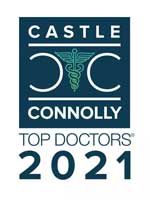

Scoliosis, or curvature of the spine, is a condition many people associate only with adolescents. But adults can have scoliosis as well. Adult scoliosis is defined as abnormal curvature of the spine in a patient over the age of 18. Sometimes this is the result of a childhood curvature that was left untreated and has since progressed. If scoliosis occurs in an adult with no history of a childhood curvature, it is classified as adult degenerative (de novo) scoliosis.

Symptoms
As we age, many changes occur to our bodies. This is especially true in the spine. When parts of the vertebral column begin to deteriorate, many people begin to experience significant back or neck pain. Common degenerative spinal conditions include:
Any of these conditions can cause the spine to curve to the left or the right. This curvature is not only cosmetically unpleasing, it can also cause other problems such as:
Diagnosis
The first, and highly important step, in treating adult degenerative scoliosis, is obviously to make an accurate diagnosis. Dr. Goldstein may use a combination of tools and advanced diagnostic technologies:
Treatment
Most cases of adult scoliosis are treated using non-surgical methods. These may include:
Surgical correction of adult degenerative scoliosis is not common. However, it may be necessary under the following conditions:
If surgery is necessary, it may include a fusion combined with spinal instrumentation (the use of rods or screws or other implants to stabilize the spine) of two or more vertebrae. Your surgeon will determine which type of surgery is best for your condition. Be assured that if surgery is necessary, all aspects of the procedure, including risks and benefits, will be fully explained to you ahead of time.
Keep in mind, many cases of adult scoliosis need no treatment at all. A “wait and see” approach may be used to see if the curve progresses over time. In the meantime, it will be important for you to maintain your health by exercising regularly to maintain flexibility and strength, eating right, not smoking, and learning correct body mechanics (posture, the correct way to carry heavy loads, etc.) These are the best ways to prevent further back problems.
Dr. Goldstein is recognized as one of the leading spine surgeons in New York. He is a Clinical Professore of Orthopedic Surgery and Neurosurgery at the NYU School of Medicine. His expertise is sought by television, media, and magazines. His practice is focused on surgical treatment:
 Dr. Jeffrey Goldstein was recognized again in 2021 as one of America's Top Doctors .
Dr. Jeffrey Goldstein was recognized again in 2021 as one of America's Top Doctors .
Dr. Goldstein serves as Director of Education, Division of Spine Surgery and Director of the Spine Surgery Fellowship at NYU Langone Health (previously Medical Center Hospital for Joint Diseases.)

Patients from around the world travel to New York for the most advanced medical care. New York offers unrivalled facilities, accommodation, and infrastructure.